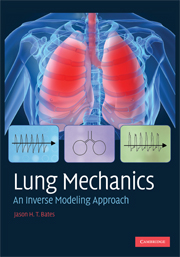Book contents
- Frontmatter
- Contents
- Preface
- Notation
- 1 Introduction
- 2 Collecting data
- 3 The linear single-compartment model
- 4 Resistance and elastance
- 5 Nonlinear single-compartment models
- 6 Flow limitation
- 7 Linear two-compartment models
- 8 The general linear model
- 9 Inverse models of lung impedance
- 10 Constant phase model of impedance
- 11 Nonlinear dynamic models
- 12 Epilogue
- References
- Index
3 - The linear single-compartment model
Published online by Cambridge University Press: 05 June 2012
- Frontmatter
- Contents
- Preface
- Notation
- 1 Introduction
- 2 Collecting data
- 3 The linear single-compartment model
- 4 Resistance and elastance
- 5 Nonlinear single-compartment models
- 6 Flow limitation
- 7 Linear two-compartment models
- 8 The general linear model
- 9 Inverse models of lung impedance
- 10 Constant phase model of impedance
- 11 Nonlinear dynamic models
- 12 Epilogue
- References
- Index
Summary
Establishing the model
Model structure
The first step in constructing a model of any physiological system is to decide on the structure of the model; how may independent components will it have, what do these components represent, and how are they connected to each other? There is no universally applicable answer to any of these questions, so one must be guided by whatever factors pertain to the situation at hand.
In addressing the question of how to model lung mechanics in the simplest possible terms, it is intuitively rather obvious that the lung can be viewed as being like a balloon sealed over the end of a pipe (Fig. 1.4). This model has a clear anatomical analogy to a real lung; the pipe represents the conducting airways and the balloon represents the elastic parenchymal tissue. There is also a functional analogy; the balloon can be inflated and deflated through the pipe in the same way that a lung inspires and expires. It goes without saying, of course, that a real lung is vastly more complicated than this simple construct. On the other hand, it is difficult to see how one could devise a simpler model that has any useful resemblance to the real thing. A tour of the universe of lung models, therefore, starts with the single-compartment model.
Although the balloon-on-a-pipe configuration shown in Fig. 1.4 is commonly how the lung is viewed, from now on we will be considering the representation shown in Fig. 3.1.
Information
- Type
- Chapter
- Information
- Lung MechanicsAn Inverse Modeling Approach, pp. 37 - 61Publisher: Cambridge University PressPrint publication year: 2009
Accessibility standard: Unknown
- 19
- Cited by
